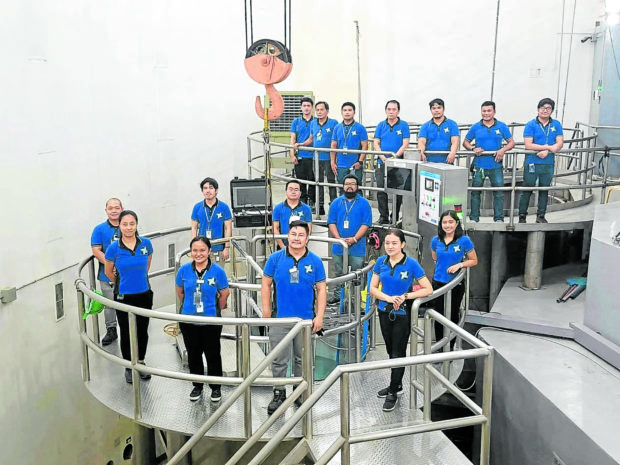PH nuclear research team has reason to feel energized

Photo shows the staff operating the reactor led by PNRI associate scientist Alvie Astronomo (front rightmost). —(Photo from the Philippine Nuclear Research Institute of the Department of Science and Technology)
MANILA, Philippines — The first nuclear facility in the country is not the Bataan Nuclear Power Plant (BNPP), which was never operated after its construction was finished in 1984.
Rather, the distinction goes to the Philippine Research Reactor-1 (PRR-1), housed in the prominent egg-shaped dome at the compound of the Philippine Nuclear Research Institute (PNRI) on Commonwealth Avenue, Quezon City.
The reactor, which was first activated in 1963 under the administration of President Diosdado Macapagal, is still the only nuclear facility so far to have been operated in the Philippines. It was shut down in 1988 and was practically mothballed for more than three decades.
But on June 20, the PNRI, an agency of the Department of Science and Technology, began loading a total of 44 fuel rods to PRR-1, completing that process four days later.
Fuel rods are metal tubes used for funneling fissionable material that serves as fuel for nuclear reactors.
Article continues after this advertisementThe PNRI said the complete loading of fuel rods on June 24 marked the reactivation of PRR-1 after 34 years.
Article continues after this advertisementAlternative energy
PNRI Director Carlo Arcilla said the commissioning of the country’s sole nuclear reactor is “very timely,” given the “very keen” interest of President Ferdinand Marcos Jr. to tap nuclear power as an alternative energy source.
“This demonstrates that the PNRI can handle nuclear materials. We’ve been handling it for the past 60 years,” he said.
But the facility has also been deemed “subcritical” with “zero power configuration,” said associate scientist Alvie Astronomo, project leader behind the reactor’s reactivation.
This, she said, is why the facility has been repurposed for training and developing manpower — which explains the reactor’s other name, the PRR-1 Subcritical Assembly for Training, Education and Research (PRR-1 Sater).
According to Astronomo, PRR-1 Sater is classified as a subcritical assembly (SCA). “As such, SCAs are inherently safe due to lesser radiation exposure and lower risk of criticality accidents compared to critical nuclear facilities and higher power reactors,” she said.
‘Local capacity’
“Although SCAs have limited capabilities, these facilities tend to be flexible and can be utilized for applications that are ideal for countries starting a nuclear science and technology program, like the Philippines,” she added.
What remaining tools the PNRI has in its possession will also be put to use, such as the more than a hundred fuel rods stored in the agency’s premises.
But the most important thrust in pursuing nuclear technology is training people in that field, Astronomo said.
“With PRR-1 Sater, we can strengthen local capacity in nuclear and reactor physics. We can also showcase the capability of our local engineers and scientists to construct and maintain a subcritical nuclear facility, which we can develop for larger nuclear facilities,” she said.
Reviving the Bataan plant
Meanwhile, her agency began introducing nuclear education programs at the University of the Philippines in Diliman and at Mapua University.
Related courses include nuclear reactor engineering, neutron physics, reactor physics, and nuclear safety, among others.
Before Marcos was sworn into office on Thursday, stakeholders in the energy sector were already considering proposals to introduce nuclear energy, including reviving the mothballed BNPP in the town of Morong, Bataan province.
One interested party, Korea Electric Power Corp., has conducted a feasibility study which found that the nuclear plant could be rehabilitated in four to five years at an estimated cost of around $1 billion.
But a number of critical issues continue to bedevil the prospect of reviving the plant, including its proximity to Mt. Natib, a dormant volcano also in Morong, and to the Lubao fault in Pampanga province, which extends to the BNPP’s area.
The shelved nuclear plant was also hounded by corruption charges—as its original estimated cost of $600 million swelled to $2.3 billion—and by questions about the safety and structural integrity of that facility.
The controversy over the BNPP has somehow tainted the country’s option to pursue nuclear energy, according to Arcilla.
“For so long, the word ‘nuclear’ has been demonized in the country. When the word is mentioned, people would think about bombs … and wars, or even corruption because of the BNPP,” he said.
‘Right push’
Arcilla argued that “with the right push, we can tap nuclear research to help us in a lot of things.”
“President Marcos is serious about tapping nuclear energy because he understands the gravity of the situation with the looming power crisis,” he said, as he cited restrictions in coal imports and the depletion two years from now of deepwater gas reserves at the Malampaya gas field off Palawan province.
He also noted that Filipinos pay one of the highest power costs worldwide, with families allotting 10 percent of their monthly incomes to electricity bills.
He cited further the advantage of nuclear research for potential breakthroughs in agriculture, medicine and other fields—including affordable cancer diagnosis, which the PNRI is developing using nuclear technology.
With the revived interest in nuclear power led by the president himself, “we are hopeful that the government will support our scientists by providing us with a bigger budget,” Arcilla said.
“This will help us regain our scientists abroad, with them returning to our country to provide their knowledge and talents for the people,” he added.
RELATED STORIES
Bataan nuclear plant safe to revive – PNRI
Geologist warns vs activating BNPP